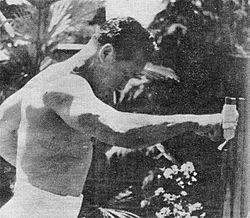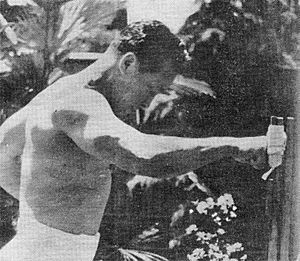Mas Oyama facts for kids
Quick facts for kids Masutatsu Oyama (Choi Bae-dal) |
|
|---|---|
 |
|
| Born | Choi Yeong-eui July 27, 1923 Kintei, Zenrahoku-dō, Korea (now Gimje, North Jeolla Province, South Korea) |
| Died | April 26, 1994 (aged 71) Tokyo, Japan |
| Height | 173 cm (5 ft 8 in) |
| Style | Kyokushin |
| Teacher(s) | Gigō Funakoshi, Gōgen Yamaguchi, Nei-Chu So |
| Rank | 10th Dan Black Belt in Kyokushin Karate |
| Spouse | Chiyako Oyama (1946–1994) |
| Children | 3 |
| Notable students | (see below) |
| Choi Bae-Dal | |
| Hangul |
최배달
|
|---|---|
| Hanja | |
| Revised Romanization | Choe Baedal |
| McCune–Reischauer | Ch'oe Paetal |
| Kyokushin | |
| Hangul |
극진
|
|---|---|
| Hanja | |
| Revised Romanization | Geukjin |
| McCune–Reischauer | Kŭkchin |
Masutatsu Ōyama (born Choi Yeong-eui; July 27, 1923 – April 26, 1994), often called Mas Oyama, was a famous karate master. He created Kyokushin Karate, which is known as the first and most important style of full contact karate. Full contact karate means fighters hit each other with full power. Oyama was a Korean person living in Japan (called a Zainichi Korean). He lived most of his life in Japan and became a Japanese citizen in 1968.
Contents
Early Life and Training
Mas Oyama was born as Choi Yeong-Eui in Kintei, Korea. When he was young, he moved to Manchukuo to live on his sister's farm. At age nine, Oyama started learning Chinese martial arts from a Chinese farmer named Lee. Oyama said Lee was his very first teacher. His family was wealthy, and his father was a well-known poet.
In March 1938, Oyama moved to Japan. There, he chose his Japanese name, Oyama Masutatsu. This name came from "Baedal," an ancient Korean kingdom.
One story from Oyama's youth tells how his teacher, Lee, gave him a seed to plant. Lee told him to jump over the sprout one hundred times every day as it grew. Oyama later said that as the plant got taller, he could easily jump between walls. This story inspired a famous comic book series called "Karate Baka Ichidai," meaning "Karate Fanatic."
In 1963, Oyama wrote a book called What is Karate. This book became very popular in the United States and sold millions of copies worldwide. Many people still call it the "Bible" of Karate. It was translated into several languages, including Hungarian, French, and English.
Training After World War II
After World War II ended in 1945, Oyama moved to Tokyo. There, he met his future wife, Oyama Chiyako.
In 1946, Oyama went to Waseda University to study sports science. He wanted to learn from the best karate teachers. He joined the Shotokan dojo (karate school) run by Gigō Funakoshi. Gigō was the son of Gichin Funakoshi, who founded Shotokan karate. Oyama became a student and began his long career in karate. To focus completely, he often trained alone.
Oyama also studied Gōjū-ryū karate with Nei-Chu So. Nei-Chu So was a Korean teacher from Oyama's home province. He was a senior student of Chojun Miyagi, who founded the Goju-Ryu system.
Around this time, Oyama trained at a dojo called Kanbukan. This dojo was known for its full-contact training using protective gear. This style allowed students to hit with full force. This experience likely influenced Oyama's ideas about full-contact fighting.
After the war, Oyama felt very angry because he had lost many friends. He decided to retreat to a lonely mountain to train his mind and body. He planned to stay on Mt. Minobu for three years. He built a small hut there. One student joined him but left after a short time because the training was so hard. Oyama stayed on the mountain for fourteen months. He returned to Tokyo much stronger and more skilled in karate.
Oyama said that reading The Book of Five Rings by Miyamoto Musashi changed his life. Musashi was a famous Japanese swordsman. Oyama said this book was the only thing he read during his mountain training.
He had to leave the mountain because his sponsor stopped supporting him. Later, after winning a karate championship, he felt sad that he hadn't completed his three-year goal. So, he went back to solitude on Mt. Kiyosumi for 18 months.
Creating Kyokushin Karate
In 1953, Oyama opened his own karate school, called Oyama Dojo, in Tokyo. He also traveled around Japan and the world. He gave amazing martial arts demonstrations. These included knocking live bulls unconscious with his bare hands. Sometimes, he would even grab a bull's horn and snap it off.
His dojo started outdoors but moved into a ballet school in 1956. Oyama's teaching style quickly became known as tough and powerful. It was also very practical. In 1957, this style was officially named Kyokushinkai. This name means 'the ultimate truth.'
Oyama was known for being strict with his students. Training sessions were very hard, and students often got hurt during practice fighting, called kumite. Unlike other karate schools, Oyama's style focused on full-contact kumite. It also emphasized breaking objects like boards or bricks. This showed a person's strength and skill. Oyama believed that if you couldn't break things, your karate was not useful.
As his dojo's reputation grew, many students came to train there. They came from Japan and other countries. In 1964, Oyama moved his dojo to a new building. This became the main Kyokushin headquarters. He also officially started the 'International Karate Organization Kyokushin kaikan' (IKO). This organization helped manage the many schools teaching Kyokushin.
In 1969, Oyama held the first All-Japan Full Contact Karate Open Championships. This event was a huge success in Japan. Terutomo Yamazaki became the first champion. These championships have been held every year since. In 1975, the first World Full Contact Karate Open Championships took place in Tokyo. World championships are now held every four years.
Oyama and his instructors were very good at promoting Kyokushin. He would send instructors to open new dojos in different towns. These instructors would show their karate skills in public places. This helped them gain new students. Oyama also sent instructors to other countries. This helped spread Kyokushin to places like the United States, Europe, Australia, and Brazil.
Amazing Demonstrations
Oyama created a challenge called the 100-man kumite. In this challenge, a karateka fights 100 opponents in a row. Oyama completed this challenge three times over three days.
He was also famous for fighting bulls with his bare hands. He battled 52 bulls during his life. He was known for knocking them unconscious or breaking their horns. Because of his incredible strength, people called him "Godhand."
Later Years and Legacy
Mas Oyama was married to Chiyako Oyama and had children. He also had other children with a family friend, Sun-ho Hong. He remained connected to both families throughout his life.
Later in his life, Oyama suffered from a joint disease called osteoarthritis. Even with his illness, he never stopped training. He continued to give karate demonstrations, including breaking objects.
Oyama wrote more than 80 books in Japanese. Some of these books were translated into other languages.
Oyama built his International Karate Organization, Kyokushinkaikan, into a huge group. It had branches in over 100 countries and more than 12 million members. In Japan, many books, movies, and comic books were made about his exciting life.
Mas Oyama passed away on April 26, 1994, in Tokyo, Japan, at the age of 70. He died from lung cancer.
His wife, Chiyako Oyama, created a foundation to honor his life's work.
Books by Mas Oyama
- What is Karate?, 1963. ISBN: 0-87040-147-5
- This is Karate!, 1965. ISBN: 0-87040-254-4
- Mastering karate, 1966. ISBN: 9780448017471
- Vital Karate, 1967. ISBN: 2-901551-53-X
- Advanced Karate, 1970. ASIN B000BQYRBQ ISBN: 9780870400018
- Essential Karate, 1978. ISBN: 978-0-8069-8844-3
- The Kyokushin way : Mas. Oyama's karate philosophy, 1979. ISBN: 9780870404603
- Mas Oyama's complete karate course, 1998. ISBN: 9780806988450
See also
 In Spanish: Masutatsu Ōyama para niños
In Spanish: Masutatsu Ōyama para niños


